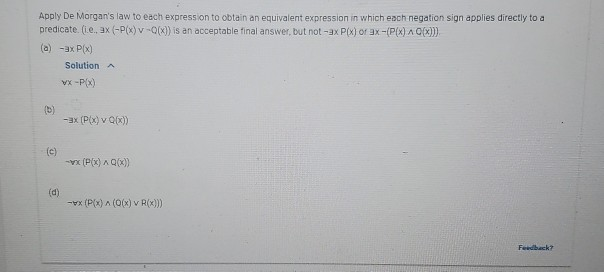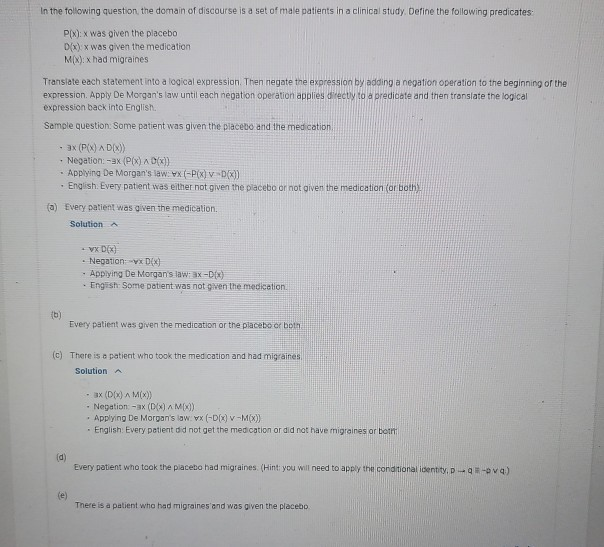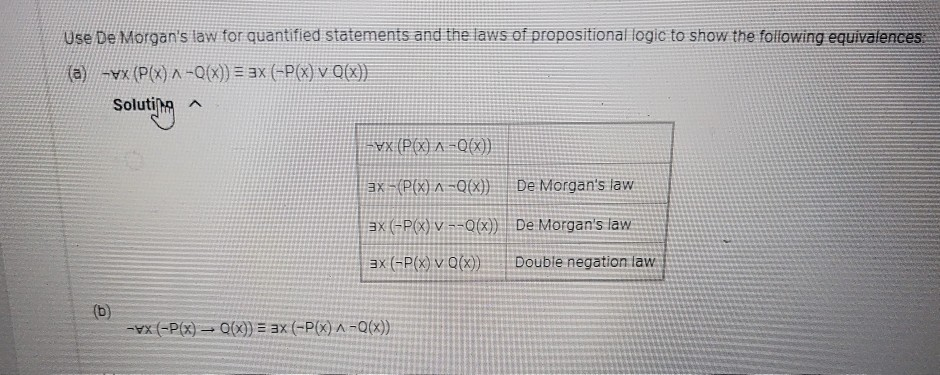Answered step by step
Verified Expert Solution
Question
1 Approved Answer
Do c and d Do b, d, e Do b Apply De Morgan's law to each expression to obtain an equivalent expression in which each

Do c and d

Do b, d, e

Do b
Apply De Morgan's law to each expression to obtain an equivalent expression in which each negation sign applies directly to a predicate. (i.e., 3x (-P(x) v -Q(x)) is an acceptable final answer, but not -ax P(x) or 3x-(P(x) A Q(x))). (a) -ax P(x) SolutionA Vx -P(x) (b) -3x (P(x) v Q(x) (e) -x (P(x) A Q(x) (d) -vx (P(x) A (O(x) v R(x)) Feedback? In the following question the domain of discourse is a set of male patients in a clinical study. Define the following predicates: P(x): X was given the placebo D(x): x was given the medication M(X): x had migraines Transiate each statement into a logical expression. Then negate the expression by adding a negation operation to the beginning of the expression. Apply De Morgan's law until each negation operation applies directly to a predicate and then translate the logical expression back into English. Sample question: Some patient was given the placebo and the medication. - ax (P(X) A D(X) Negation: -ax (P(x) A D(x)) - Applying De Morgan's law: VX (-P(x) v D(x)) English. Every patient was either not given the placebo or not given the medication (or both) a) Every patient was given the medication. Solution A vx D(x) Negation: vx D(X) Applying De Morgans law: ax -Dx) Engish: Some patient was not given the medication. (b) Every patient wes given the medication or the placebo or botn (c) There is a patient who took the medication and had migraines Solution ax (D(x) A M(x) - Negation -ax (D(x) A M(X) Applying De Morgan's law: vx (-D(x) v -M(X) English: Every petient did not get the medication or did not have migraines or botn (d) Every patient who took the piacebo had migraines. (Hint: you will need to apply the conditional identity, p-aE-va) (e) There is a patient who had migraines and was given the placebo Use De Morgan's law for quantified statements and the laws of propositional logic to show the following equivalences (a) -vx (P(x) ^ -Q(x)) = 3x (-P(x) v Q(x)) solutg Vx (P(x) a ~Q(x)} ax -(P(x) ^ ~Q(x)) De Morgan's law ax (-P(x) v --Q(x)) De Morgan's law ax (P(x) v Q(x)) Double negation law (b) Vx (-P(x) Q(x)) = 3x (-P(x) ^ Q(x))Step by Step Solution
There are 3 Steps involved in it
Step: 1

Get Instant Access to Expert-Tailored Solutions
See step-by-step solutions with expert insights and AI powered tools for academic success
Step: 2

Step: 3

Ace Your Homework with AI
Get the answers you need in no time with our AI-driven, step-by-step assistance
Get Started


